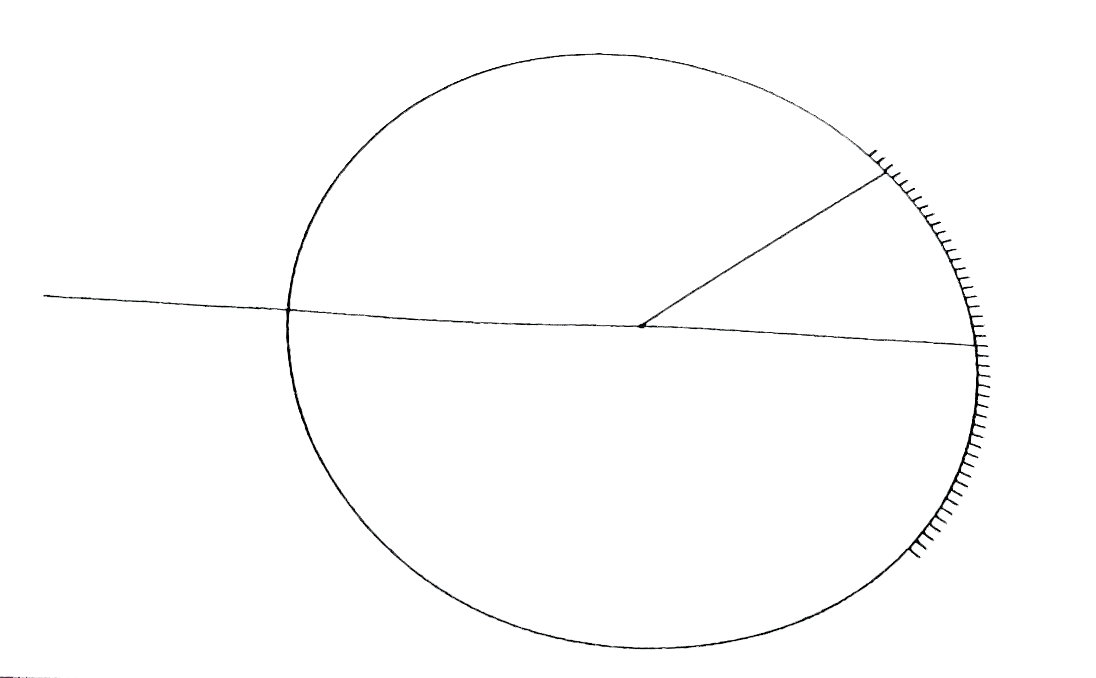Explain the following terms related to spherical lenses :
(i) Centers of curvature
(ii) Principal axis
(iii) Optic centre
(iv) Radii of curvature
(v) Principal focus
(vi) Focal length and
(vii) Linear aperture.
(i) Each spherical surface of a spherical lens forms a part of a sphere. The centres of these spheres are called the centres of curvature.
(ii) The principal axis of a lens is a imaginary line passing through its two centres of curvature.
(iii) The central point of a lens is called its optical centre. A ray of light passes undeviated through the optical centre of any lens.
(iv) The radii of two spherical surfaces of the lens are called radii of curvature.
(v) The point on the principal axis, at which incident light rays parallel to the principal axis converge or appear to diverge from, is called the principal focus of the lens.
(vi) The distance between the optical centre and the principal focus of a spherical lens is called its focal length.
(vii) The aperture of a spherical lens is the diameter of its circular outline.
Topper's Solved these Questions
- LIGHT - REFLECTION AND REFRACTIONBOOK - ZEN PUBLICATIONCHAPTER - LIGHT - REFLECTION AND REFRACTIONEXERCISE - ZEN ADDITIONAL QUESTIONS SECTION (LONG ANSWER [LA] QUESTIONS)
30 Videos
- LIGHT - REFLECTION AND REFRACTIONBOOK - ZEN PUBLICATIONCHAPTER - LIGHT - REFLECTION AND REFRACTIONEXERCISE - ZEN ADDITIONAL QUESTIONS SECTION (SHORT ANSWER [SA] TYPE - I QUESTIONS)
28 Videos
- ELECTRICITYBOOK - ZEN PUBLICATIONCHAPTER - ELECTRICITYEXERCISE - ZEN ADDITIONAL QUESTIONS SECTION (MULTIPLE CHOICE QUESTIONS)
60 Videos
- MAGNETIC EFFECTS OF ELECTRIC CURRENT BOOK - ZEN PUBLICATIONCHAPTER - MAGNETIC EFFECTS OF ELECTRIC CURRENT EXERCISE - Additional question section (Higher-order thinking skills [HOTS] questions)
20 Videos
Similar Questions
(a) Explain the following terms related to spherical lenses :
(i) optical center (ii) centre of curvature.
(iii) prinicipal axis (iv) aperture
(v) principal focus (vi) focal length
(b) A converging lens has focal length of 12 cm. Calculate at what distance should the object be placed from the lens so that it forms an image at 48 cm on the other side of the lens.
View SolutionDefine the following terms in the context of spherical mirrors :
Pole, centre of curvature, principal axis, and principal focus.
View Solution
Knowledge Check
Write the following steps in sequential order to determine nature of the image formed by a concave mirror where an object is placed at the centre of curvature with the help of a ray diagram.
(A) Mark the position of the object infornt of the mirror at the centre of curvature.
(B) Draw a diagram, which represents a concave mirror.
(C) Draw two lines one passing through F and another line parallel to the principal axis and draw the path of the reflected rays.
(D) Draw the principal axis and mark the centre of curvature and principal focus.
(E) Mark the position of the image and study its nature.ABDACEBBCADECABDCEDABCDEWrite the following steps in sequential order to determine nature of the image formed by a concave mirror where an object is placed at the centre of curvature with the help of a ray diagram.
(A) Mark the position of the object infornt of the mirror at the centre of curvature.
(B) Draw a diagram, which represents a concave mirror.
(C) Draw two lines one passing through F and another line parallel to the principal axis and draw the path of the reflected rays.
(D) Draw the principal axis and mark the centre of curvature and principal focus.
(E) Mark the position of the image and study its nature.ABDACEBBCADECABDCEDABCDE
Define the following terms in the context of spherical mirrors :
(i) Pole
(ii) Centre of curvature
(iii) Radius of curvature
(iv) Principal axis
(v) Principal focus
View SolutionIndicate the following terms related to spherical mirrors in figure : pole, centre of curvature , radius of curvature , principal focus.

View SolutionDefine the following terms related to curved mirrors :
(A) Focus (b) Principal axis ( c ) Centre of curvature (d) Radius of curvature
View SolutionExplain the following terms with suitable examples :
(i) Schottky defect
(ii) Frenkel defect
(iii) Interstitials
(iv) F-centres.
View SolutionWith reference to spherical lenses, state the meaning of the following terms or define the following terms and draw the diagrams to illustrate the same : (1) centre of curvature (C) (2) radii of curvature (R1,R2) (3) principal axis (4) optical centre (O) (5) principal focus (F) (6) focal length (f)
View SolutionDefine the following : (a) Principal axis,
(b) Focal ength, ( c ) Pole (d) Centre of curvature.
View Solution
